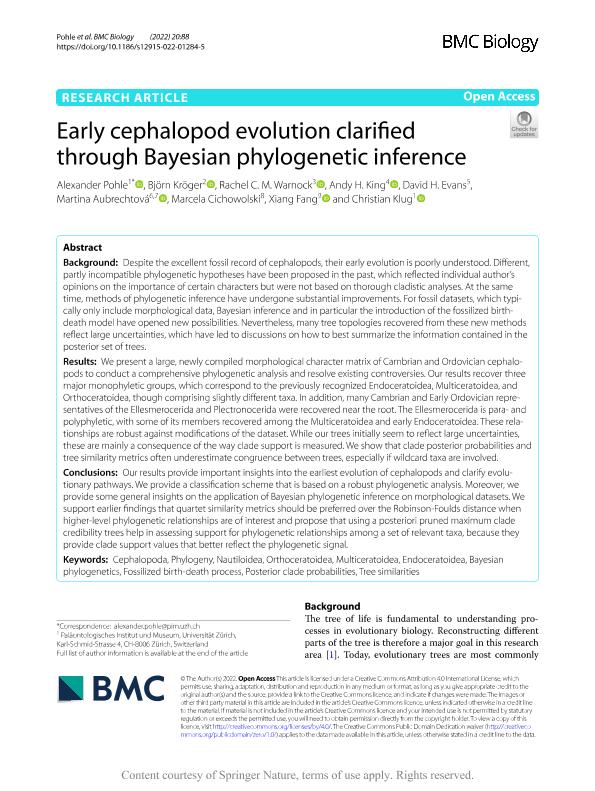Artículo
Early cephalopod evolution clarified through Bayesian phylogenetic inference
Pohle, Alexander; Kröger, Björn; Warnock, Rachel C. M.; King, Andy H.; Evans, David H.; Aubrechtová, Martina; Cichowolski, Marcela ; Fang, Xiang; Klug, Christian
; Fang, Xiang; Klug, Christian
 ; Fang, Xiang; Klug, Christian
; Fang, Xiang; Klug, Christian
Fecha de publicación:
12/2022
Editorial:
BioMed Central
Revista:
Bmc Biology
ISSN:
1741-7007
Idioma:
Inglés
Tipo de recurso:
Artículo publicado
Clasificación temática:
Resumen
Background: Despite the excellent fossil record of cephalopods, their early evolution is poorly understood. Different, partly incompatible phylogenetic hypotheses have been proposed in the past, which reflected individual author’s opinions on the importance of certain characters but were not based on thorough cladistic analyses. At the same time, methods of phylogenetic inference have undergone substantial improvements. For fossil datasets, which typically only include morphological data, Bayesian inference and in particular the introduction of the fossilized birth-death model have opened new possibilities. Nevertheless, many tree topologies recovered from these new methods reflect large uncertainties, which have led to discussions on how to best summarize the information contained in the posterior set of trees. Results: We present a large, newly compiled morphological character matrix of Cambrian and Ordovician cephalopods to conduct a comprehensive phylogenetic analysis and resolve existing controversies. Our results recover three major monophyletic groups, which correspond to the previously recognized Endoceratoidea, Multiceratoidea, and Orthoceratoidea, though comprising slightly different taxa. In addition, many Cambrian and Early Ordovician representatives of the Ellesmerocerida and Plectronocerida were recovered near the root. The Ellesmerocerida is para- and polyphyletic, with some of its members recovered among the Multiceratoidea and early Endoceratoidea. These relationships are robust against modifications of the dataset. While our trees initially seem to reflect large uncertainties, these are mainly a consequence of the way clade support is measured. We show that clade posterior probabilities and tree similarity metrics often underestimate congruence between trees, especially if wildcard taxa are involved. Conclusions: Our results provide important insights into the earliest evolution of cephalopods and clarify evolutionary pathways. We provide a classification scheme that is based on a robust phylogenetic analysis. Moreover, we provide some general insights on the application of Bayesian phylogenetic inference on morphological datasets. We support earlier findings that quartet similarity metrics should be preferred over the Robinson-Foulds distance when higher-level phylogenetic relationships are of interest and propose that using a posteriori pruned maximum clade credibility trees help in assessing support for phylogenetic relationships among a set of relevant taxa, because they provide clade support values that better reflect the phylogenetic signal.
Archivos asociados
Licencia
Identificadores
Colecciones
Articulos(IDEAN)
Articulos de INSTITUTO DE ESTUDIOS ANDINOS "DON PABLO GROEBER"
Articulos de INSTITUTO DE ESTUDIOS ANDINOS "DON PABLO GROEBER"
Citación
Pohle, Alexander; Kröger, Björn; Warnock, Rachel C. M.; King, Andy H.; Evans, David H.; et al.; Early cephalopod evolution clarified through Bayesian phylogenetic inference; BioMed Central; Bmc Biology; 20; 1; 12-2022; 1-31
Compartir
Altmétricas



